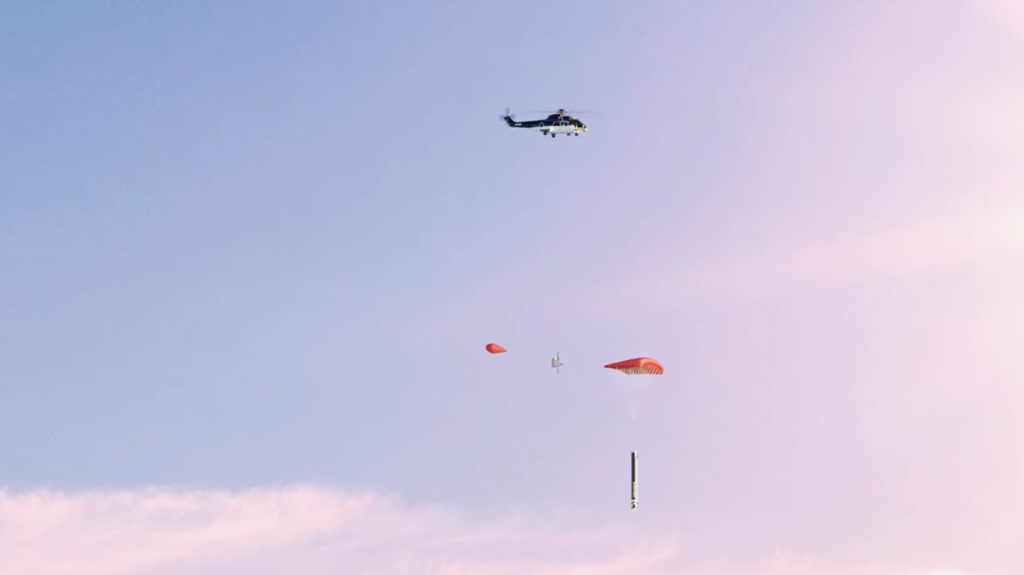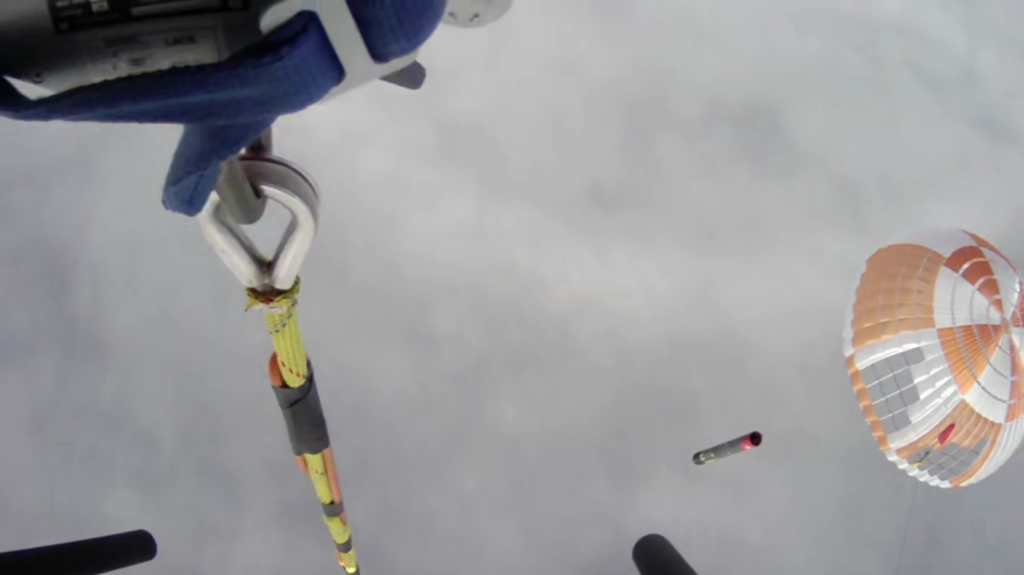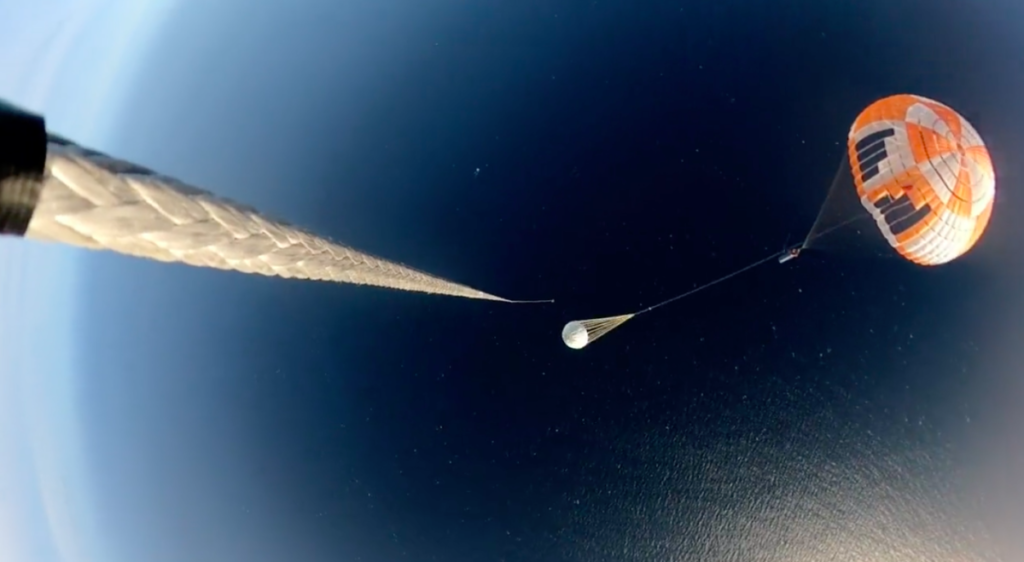
When Is Rocket Lab Going To Try Catching Electron’s Booster Again?
Rocket Lab has been an exciting company to watch as they continue to grow and try new things. Over the past few years, Rocket Lab has managed to achieve many firsts and has proven they have no shortage of ambitious ideas. One great example has been the journey of Electron partial reusability and the process of catching Electron’s booster out of mid-air.
Specifically, earlier this year in May we watched Rocket Lab’s first official Electron booster catch during an actual mission. While the company was not able to successfully snag the booster and return it to the shore, they were close and gathered a lot of invaluable information. This brings up the question of when should we expect the next booster catch attempt.
Based on updates from the company along with future mission details, it’s possible we see this attempt just weeks from now in November. If successful, this will mark a major milestone and help the company by improving launch cadence and reducing costs. Here I will go more in-depth into when we should expect the next catch attempt, the booster catch process, the future of Electron reusability, and more.
Upcoming Catch Attempt

Back in May of this year, during the “There And Back Again” mission we saw Rocket Lab complete a mid-air capture of the Electron booster with a helicopter for the first time. After launching to space, Electron’s first stage returned to Earth under a parachute. At 6,500 ft, Rocket Lab’s Sikorsky S-92 helicopter rendezvoused with the returning stage and used a hook on a long line to capture the parachute line. The mid-air capture is a major milestone in Rocket Lab’s pursuit to make Electron a reusable rocket to increase launch frequency and reduce launch costs for small satellites. After the catch, the helicopter pilot detected different load characteristics than previously experienced in testing and offloaded the stage for a successful splashdown. In terms of the next attempt, while Rocket Lab for the most part has not said much regarding this next mission, the company has given a few hints that give us a good idea of when we should expect it.
Just a few months ago in September Rocket Lab tweeted saying, “So when’s our next recovery mission, you ask? It’s on track to take place before the end of the year. And yes, we will be bringing back the helicopter.” Currently, there is already a mission scheduled in December however this is planned to be the first mission from U.S. soil at Launch Complex 2. Rocket Lab will not be attempting a booster catch attempt on the first launch from that complex and country, which leaves it up to missions from LC-1. If the next catch attempt is still scheduled for this year, practically the only opportunity will be the next mission in November. As of right now, Rocket Lab is still yet to announce its next mission. This combined with some of the other factors indicates that within only a few weeks we could receive an announcement from the company and an official date for the next catch attempt.
This mission would mark the 5th booster reusability test and the second mid air catch attempt. The last mid-air capture comes after successful recovery operations from Rocket Lab’s 16th, 20th, and 22nd missions, which saw Electron’s first stage execute a controlled ocean splashdown before being returned to Rocket Lab’s production complex. Like those missions, a reaction control system re-oriented the first stage to an ideal angle for re-entry during the “There And Back Again” mission, enabling the stage to survive the incredible heat and pressure during its descent back to Earth. A drogue parachute was deployed to increase drag and to stabilize the first stage as it descended, before a large main parachute was deployed in the final kilometers of descent. “There And Back Again” is the first time a helicopter catch attempt was introduced to recovery operations and provided a lot of invaluable information for the next mission.
Electron Reusability

Now that we have a better idea of when the next catch attempt could happen, we can take a closer look at the process of catching Electron’s booster and what benefits it provides. Rocket Lab points out that its recovery program aims to make Electron the first reusable small launch vehicle to enable even more frequent launch opportunities for the small sat community. Rocket Lab attempts the catch with a customized Sikorsky S-92, a large twin engine helicopter typically used in offshore oil and gas transport and search and rescue operations. They highlight that catching a returning rocket stage mid-air as it returns from space is a highly complex operation that demands extreme precision. Several critical milestones must align perfectly to ensure a successful capture.
In terms of an Electron booster catch mission profile, it begins approximately an hour prior to lift-off, here, Rocket Lab’s helicopter will move into position in the capture zone, approximately 150 nautical miles off New Zealand’s coast, to await launch. At about two and a half minutes after lift-off, Electron’s first and second stages will separate per a standard mission profile. Electron’s second stage will continue on to orbit for payload deployment and Electron’s first stage will begin its descent back to Earth reaching speeds of almost 8,300 km (5,150 miles) per hour. The stage will reach temperatures of around 2,400 degrees C (4,352 F) during its descent.
After deploying a drogue parachute at 13 km (8.3 miles) altitude (about seven and a half minutes after lift-off), the main parachute will be extracted at around 6 km (3.7 miles) altitude to dramatically slow the stage to 10 meters per second, or 36 km (22.3 miles) per hour (about eight minutes and 12 seconds after lift-off). As the stage enters the capture zone, Rocket Lab’s helicopter will attempt to rendezvous with the returning stage and capture the parachute line via a hook. Once the stage is captured and secured, the helicopter will attempt to offload the stage onto Rocket Lab’s recovery vessel for transport back to land. Rocket Lab will conduct a thorough analysis of the stage and assess its suitability for reflight. If everything goes according to plan, this is exactly what we will see on the next attempt.
After the first catch attempt, CEO of Rocket Lab Peter Beck said, “Bringing a rocket back from space and catching it with a helicopter is something of a supersonic ballet. A tremendous number of factors have to align and many systems have to work together flawlessly, so I am incredibly proud of the stellar efforts of our Recovery Team and all of our engineers who made this mission and our first catch a success. From here we’ll assess the stage and determine what changes we might want to make to the system and procedures for the next helicopter catch and eventual re-flight.”
To put this process in perspective, re-entering Earth’s atmosphere is a brutal experience. Electron’s first stage is subjected to intense pressure and heat, experiencing flow temperatures in excess of 2400 °C and reaching speeds of 2350 m/s during its descent. Rocket Lab calls this potentially destructive process ‘The Wall.’ One of the ways they set out to survive ‘The Wall’ was by using a reaction control system (RCS) to position the stage as it falls. Using the RCS they are able to reorient the stage to an ideal angle as it descends. They have tested the RCS on mulitple previous missions and data showed good positioning, but there’s nothing like getting the stage back to prove it. On Return to Sender, Stage 1 reoriented perfectly, with the RCS performing nicely to position the stage for the perfect re-entry angle of attack. This set them up well for parachute deployment.
Peter Beck has also commented mentioning, “As one of only two launch companies to repeatedly recover orbital-class boosters from space, we’re ready to take the final step and begin collecting them mid-air with a helicopter to race us closer to launch, catch, repeat with the world’s first reusable, orbital-class commercial small rocket. A reusable Electron means more rockets and launch opportunities for better access to space for satellite customers, and I’m proud of the Rocket Lab team for continuously pushing the industry forward as the leaders in dedicated small launch.”
Lastly, it’s hard to explain the amount of crucial information gained from the last attempt. For example, in September, Rocket Lab successfully test fired a reused Rutherford first stage engine from the previous flight. Specfiicaly, Rocket Lab conducted the full duration, full-thrust test fire of the refurbished Rutherford engine earlier this year at the Company’s engine test facility. The engine was previously successfully launched to space and returned to Earth during Rocket Lab’s recent recovery mission, ‘There And Back Again’, launched on May 2, 2022. A good sign as the company continues to prepare for the next catch attempt.
Conclusion
Rocket Lab has been staying busy in the past couple of months as they work on new launch sites, next generation launch vehicles, and Electron reusability. Based on some updates and the company’s launch schedule, it’s possible we see another launch attempt not long from now in November. We will have to wait and see how it progresses and the impact it has on the space industry.
